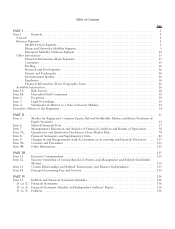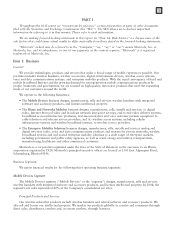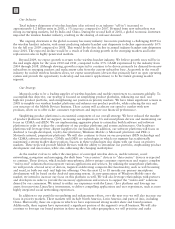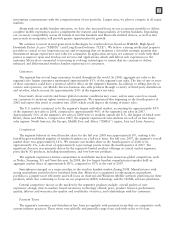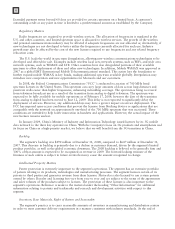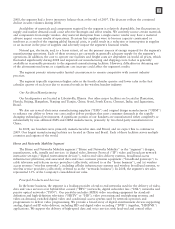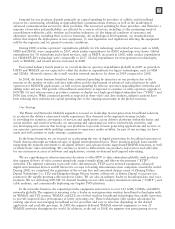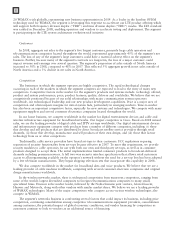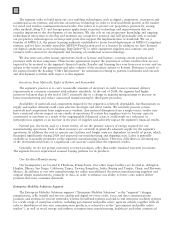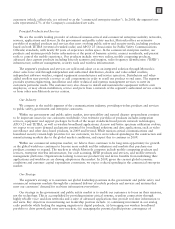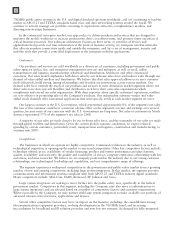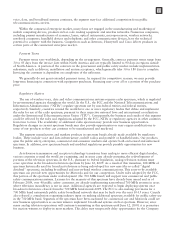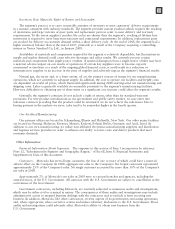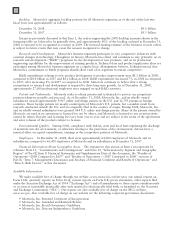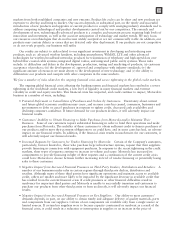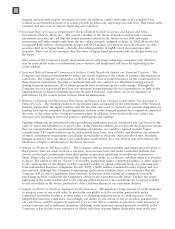Motorola 2008 Annual Report Download - page 18
Download and view the complete annual report
Please find page 18 of the 2008 Motorola annual report below. You can navigate through the pages in the report by either clicking on the pages listed below, or by using the keyword search tool below to find specific information within the annual report.
The segment seeks to build upon our core enabling technologies, such as digital compression, encryption and
conditional access systems, and wireless air-interface technology in order to lead worldwide growth in the market
for wired and wireless communications networks. Our policy is to protect our proprietary position by, among
other methods, filing U.S. and foreign patent applications to protect technology and improvements that we
consider important to the development of our business. We also rely on our proprietary knowledge and ongoing
technological innovation to develop and maintain our competitive position and will periodically seek to include
our proprietary technologies in certain patent pools that support the implementation of standards. We are a
founder of MPEG LA, the patent licensing authority established to foster broad deployment of MPEG-2-compliant
systems, and we have recently joined the MPEG4-Visual patent pool as a licensor. In addition, we have licensed
our digital conditional access technology, DigiCipher»II, to other equipment suppliers and continue our joint
ventures with Comcast for development and licensing of conditional access technology.
We also enter into other license agreements, both as licensor and licensee, covering certain products and
processes with various companies. These license agreements require the payment of certain royalties that are not
expected to be material to the segment’s financial results. Royalty and licensing fees vary from year to year and are
subject to the terms of the agreements and sales volumes of the products subject to licenses. Reference is made to
the material under the heading “Other Information” for information relating to patents, trademarks and research
and development activities with respect to this segment.
Inventory, Raw Materials, Right of Return and Seasonality
The segment’s practice is to carry reasonable amounts of inventory in order to meet customer delivery
requirements in a manner consistent with industry standards. At the end of 2008, the segment had higher
inventory balances than at the end of 2007, primarily due to a change in manufacturing strategy to increase in-
house manufacturing and reduce outsourced manufacturing by third-party providers.
Availability of materials and components required by the segment is relatively dependable, but fluctuations in
supply and market demand could cause selective shortages and affect results. We currently procure certain
materials and components from single-source vendors. Any material disruption from a single-source vendor may
have a material adverse impact on our results of operations. If certain key suppliers were to become capacity
constrained or insolvent as a result of the ongoing global financial crisis, it could result in a reduction or
interruption in supplies or an increase in the price of supplies and adversely impact the segment’s financial results.
Natural gas, electricity, and, to a lesser extent, oil are the primary sources of energy required for our
manufacturing operations. Each of these resources are currently in generally adequate supply for the segment’s
operations. In addition, the cost to operate our facilities and freight costs are dependent on world oil prices, which
fluctuated significantly during 2008 and impacted our manufacturing and shipping costs. Labor is generally
available in reasonable proximity to the segment’s manufacturing facilities. However, difficulties in obtaining any
of the aforementioned items or a significant cost increase could affect the segment’s results.
Generally, we do not permit customers to return products, other than under standard warranty provisions.
The segment has not experienced seasonal buying patterns for its products.
Our Facilities/Manufacturing
Our headquarters are located in Horsham, Pennsylvania. Our other major facilities are located in: Arlington
Heights, Illinois; San Diego, California; Taipei, Taiwan; Bangalore, India; Beijing and Tianjin, China; and Reynosa,
Mexico. In addition to our own manufacturing, we utilize non-affiliated electronics manufacturing suppliers and
original design manufacturers, primarily in Asia, in order to enhance our ability to lower costs and/or deliver
products that meet consumer demands.
Enterprise Mobility Solutions Segment
The Enterprise Mobility Solutions segment (“Enterprise Mobility Solutions” or the “segment”) designs,
manufactures, sells, installs and services analog and digital two-way radio, voice and data communications
products and systems for private networks, wireless broadband systems and end-to-end enterprise mobility systems
for a wide range of enterprise markets, including government and public safety agencies (which, together with all
sales to distributors of two-way communication products, is referred to as the “government and public safety
market”), as well as retail, energy and utilities, transportation, manufacturing, healthcare and other commercial
10


